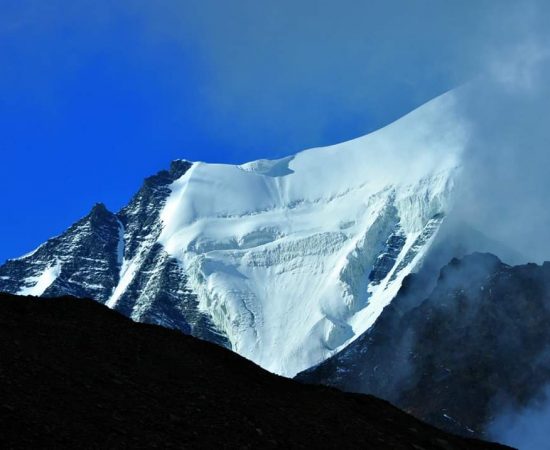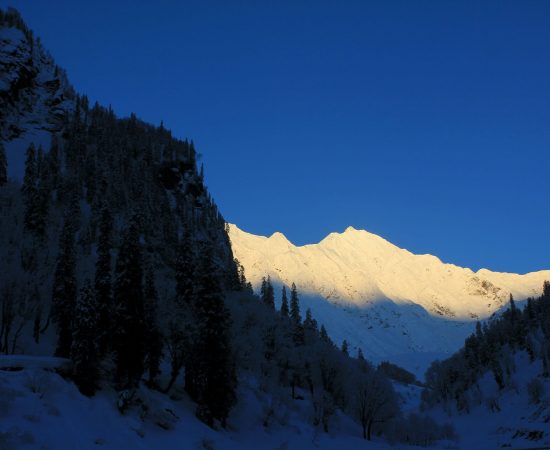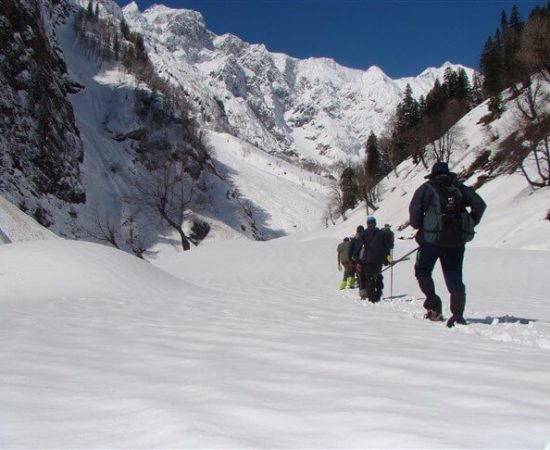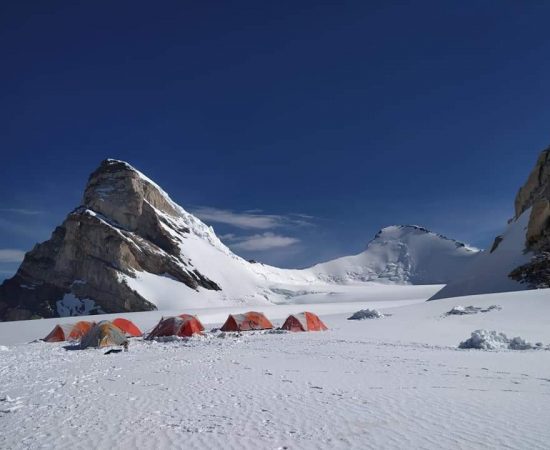CHAUKHAMBA PEAK EXPEDITION
Chamoli, Uttarakhand
Rated 4.9/5.0 on TripAdvisor. 550 Reviews


Key Highlights
- Altitude : 6325 meters
- Time : 30 Days - 29 Nights
- Region: Chamoli
- Best Time: May June to September October
- Grade: Difficult
Overview
Chaukhamba Peak Expedition
The Chaukhamba mountain range, often known as the "four pillars," is located in the Gangotri glacier in the Garwal Mountains in the Indian state of Uttarakhand. The majestic Chaukhamba Massif has a ridge that is thirty kilometres long and includes six peaks, with Chaukhamba I being the highest of the bunch. In 1952, members of a French expedition successfully climbed to the summit of the mountain for the first time. In 1967, members of an Indian team accomplished the same feat. The Chaukhamba peaks are notoriously difficult and need for an exceptional degree of technical expertise. The journey begins in the town of Mana and continues up to the base camp at Bhagirak Kharak, which is located at an elevation of 15,000 feet. As you get farther out from the base, the trail becomes treacherous and is littered with rock fall spots. We are going to transfer loads to the ABC, and then we are going to establish it. When all of the cargoes have been transferred, ABC will remain at 16000ft. Read More
A little farther away from ABC, we will proceed with the transfer of cargo to camp I. The path passes across ice cliffs that include crevasses and an area that is prone to avalanches. To ensure a safe crossing, hundreds of metres of climbing ropes have been fixed. We will soon arrive at the location that is ideal for Camp I, at which point we will unload our belongings and set up camp. Following breaking down camp I, we will make our first ascent into the Bhagirak Kharak glacier and continue our journey via the lateral moraines.
The glacier will be traversed in a south-westerly direction by our group, and along the way, one will be able to recognise the point where a smaller, nameless glacier that was formed by the ice fall of Mount Chaukhamba I meets Bhagirak Kharak. At an elevation of 18,000 feet, we will set up camp II. The path that leads to camp III is considered challenging since it passes through an icefall, has poor visibility because of erratic weather, and necessitates the use of hundreds of metres of rope on perilous slopes. After many hours of exhausting labour, we will finally arrive at the summit of the snow slope, where we will set up camp III at an altitude of 20,000 feet. The next day, we will do a reconnaissance of the higher slopes of camp III and begin roped climbing and belaying our way towards camp IV. The ascent is becoming more laborious as we go through hills covered in snow up to our knees. A few hours later, we will arrive at the ice wall that is 150 feet tall and slopes at a 70 degree angle. After overcoming the challenges, we will set up camp IV at an elevation of 22,000 feet. This will serve as our summit camp, and in the wee hours of the morning, we will begin our ascent of the mountain. The ascent to the peak consists of a variety of treacherous terrain, including snow slopes, ice cliffs, and crevasses. The ascent to the peak of Chaukhamba I, which is located at 7318 metres, will be arduous and taxing for all of us. At the summit of the towering mountain, we will stop to take pictures and then hang out there for a while. At this point, we will make our way safely back down to the summit camp as well as the lower camps. We are getting closer and closer to the base, and then we can go on to the road head. The summits of Mount Chaukhamba are, in general, the most technically challenging peaks in the Garwal Himalayas. Those who want to climb the world's highest 8000-meter peaks may benefit significantly by climbing Mt. Chaukhamba, which also offers a wide variety of climbing experiences. It has the potential to be an excellent beginning activity and may help participants comprehend the high-altitude climate, geography, and the sheer difficulties that continue to be unexpected on all difficult climbs. Hence, sign up for one of our programmes and prepare yourself for the toughest challenge in extreme climbing.
Cost Per Person
Key Highlights
- Altitude : 6325 meters
- Time : 30 Days - 29 Nights
- Region: Chamoli
- Best Time: May June to September October
- Grade: Difficult
Complete
Itinerary of Expedition
Upon arrival at the Delhi Airport, you will be met and transferred to the hotel, where you will check in and spend the night.
Visit the International Monetary Fund in the morning after breakfast for a briefing with the IMF Director and LO. Drive to Rishikesh later in the day, travelling around 240 km over the course of five to six hours. After arriving in Rishikesh, check into the hotel where you will be staying for the night.
After breakfast, go early in the morning to travel to Joshimath, which is around 170 km away and will take between six and seven hours to arrive. After arriving at Joshimath, check into the hotel where you will be staying for the night.
The legal paperwork for the Expedition in Joshimath are to be completed in the morning after breakfast. Travel to the Mana village in the latter part of the day. Spend the night at the guest house or the camp.
Following breakfast, you will make your way to Chakratirath and set up tent there for the night.
After breakfast in the morning, make your way to Satopanth Tal. Upon our arrival, you should set up our base camp. Tents are provided for the night's lodging.
Meals: Breakfast + Lunch + Dinner
The next 19–20 days will be spent acclimatising, establishing higher camp, and making an attempt to summit Mount Chaukamba–I before heading back to base camp.
Trek to Mana. Spend the night in a tent or the guest home.
Travel to Joshimath first thing in the morning after breakfast. Check into the hotel for a stay of at least one night.
After breakfast in the morning, make your way back to Rishikesh. After you have arrived, check into the hotel where you will be staying for the night.
After breakfast, make your way to Delhi, and when you get there, check into the hotel where you'll be staying for the night.
Morning after breakfast went to IMF for debriefing. The remaining part of the day is at your leisure for solo pursuits. After that, make your way to the international airport to check in for your trip to the next location.
Enquiry For Group Bookings
Guidelines
➽ Preparation for Expedition
As you well know, the great Himalayan expedition is one that requires careful preparation, a strategy that allows for enough flexibility to adapt to whatever challenges may arise.
Therefore, here are some things to consider before setting out on your Chaukhamba Peak Expedition:
⦿ Physically – You should start working out at least a month before signing up for a program if you want to be physically prepared for the rigours of a journey. Strengthen your legs by jogging and working out regularly to increase your stamina. To better acclimatise to the environment and increase your resilience on the walk, you should give up smoking and undertake breathing exercises twice a day. Engage in vigorous physical activity, such as playing sports, doing Yoga, or running.
⦿ Mentally –
Getting in shape physically is essential, but mental preparation is just as crucial for a successful walk. Take time to enjoy your regular activities, maintain a healthy diet and sleep schedule, and unwind before embarking on a hike. Predictions regarding the journey should not cause mental worry. Spend time with your closest pals to recharge your batteries and renew your spirit. Pre-trek preconceptions are unwarranted since the first contact with the other trekkers is certain to be a source of inspiration and energy. Conditions during the walk will contribute to the increase in mental readiness. The mental repercussions of physical disadvantages will not be ignored. So, when you hike, pay attention to different regions of your body and purposefully relax them. If you want to enjoy your hike, you should learn to loosen up a little, particularly in the hips. Think about your descent as a simple dance, and enjoy the natural rhythms that the path and your body can discover together gradually, whether you're on a flowing downhill route or a frightening slope. Try out a few new walking techniques to add some fun to your commute without worrying about getting somewhere in particular. Maintaining mental fitness mostly requires a willingness to relax and take in the journey, rather than subjecting oneself to undue stress.
Guidelines
➽ Things to Carry
- Good Trekking Boots: You need sturdy trekking boots with supportive high ankles. Don't bring your running shoes. U can carry extra floaters/flip flops also.
- Wear warm clothing, such three-layer coats, fleece upper, hollow fill or down-filled jackets. Carry full-sleeved T-shirt. Carry cotton hiking trek pants and warm pant for your lower body. Never bring shorts or jeans on a hike.
- Take top and bottom thermals with you.
- Quick dry towel with light weight and Personal toiletries. Suns cream lotion, sanitizer, tooth brush ad toothpaste, lip balm and antibacterial powder.
- Socks: Bring two pairs of regular socks and two pair of wool socks for wearing at night.
- A head torch is required.
- Sunglasses/ Goggle: UV-protected sunglasses are necessary to protect against sunlight and Snow Mountain.
- There should also be a woolen cap / balaclava, cap, neck gaiter cum face mask and warm fleece and waterproof summit gloves since it will be chilly. Keep waterproof gloves on hand since they become wet in the snow.
- Everyone taking part in the activity should have their own lunchbox, spoon, mug and water bottle/ hydration pack of 2 ltr.
- Raincoats/ponchos: Since snowfall and rain are frequent at high elevations, it is important to have one on hand so as to avoid getting wet.
- Trekking bag of 75 ltr with rain cover.
- Walking stick.
- Personal first aid box. Emergency ration, energy bars, dry fruit, electoral/Ors
- Personal technical gears list of mountaineering (on rent basis available)
- Climbing boot, Crampon, Sleeping bag (optional), Ice axe, seat harness, Rope and tape sling, helmet, Summit gloves, Gaiters, Carabineers 2 no (screw), figure of eight/descendor, Zumar (Ascendor),
- Required Documents:
a) Registration Form
b) Medical Certificate (signed by a licensed MBBS physician)
c) NOC form (completed by the trekker)
d) 2 passport-size photos
e) ID Proof photo (not PAN)
f) Basic Mountaineering Course certificate.
g) Insurance upto 5 lac..
Guidelines
➽ How to Reach
Travel time and distance by road:
While travelling by vehicle, Dehradun is easily accessible from several of the country's most important locations. Via Nahan, which is 95 kilometres to the north-west of Dehradun, National Highway 72 links Dehradun to Panchkula, Chandigarh, and Shimla. Haridwar is the last stop on National Highway 72 and is located 54 kilometres away from Dehradun. The distance between Delhi and Dehradun is about 235 kilometres. Dehra Dun is connected to NH58 at Roorkee, which continues on to Meerut (170 km) and Delhi. The distance between the two cities is 67 kilometres (235 km). At Delhi ISBT Kashmere Gate, passengers may board a bus at regular intervals that will take them to Dehradun.
Nearest Railway Station:-
Dehradun is linked to a number of other significant cities, including Delhi, Mussoorie, Mumbai, Varanasi, Lucknow, and Kolkata, by means of an efficient train network. From Delhi- DDN NZM AC EXPRESS (2205)
Nearest Airport:-
Jolly Grant Airport, which serves the city of Dehradun, is around 25 kilometres away from the centre of the city. There is a flight that departs from Delhi and arrives in Dehradun every day.
➽ Trip Cost Includes
- Mountaineering (Instructor/guide) services provided by a highly trained, professional, and qualified Himalayan Adventure Trips staff.
- Certified local guide with extensive familiarity of the area.
- Climbing provides only vegetarian food (breakfast, lunch, and dinner).
- Staff include chefs, cooks, and helpers.
- High Altitude Force, Low Altitude Force, Porters, Mules for Common Equipment (Rations, Tents, Utensils, Central Climbing Equipment, etc.)
- Tents (to be shared), sleeping bags, air mattresses, and air pads are included. Inner
- We offer twin-share accommodations in dome, alpine, and high-altitude tents on all of our treks and expeditions. All necessary camping equipment, including air mattresses, a shelter for cooking and eating, a table and chairs, a stool, and more, would be supplied.
- Someone who can carry heavy items, set up high camps, repair ropes, etc. at high altitudes.
- Assistance from Guide All the Way to the Top
- High-altitude butane gas cooker
- The only meal offered at the hotel will be breakfast. All meals while on the walk will be supplied for you. Indian, Chinese, and Continental cuisines, all freshly cooked, will be on the menu.
- Tin-packaged food is what we'll eat at high altitude.
- A standard first aid kit with oxygen masks for the patient.
- Camping fees, wildlife fees, and forest permits.
- Taxes imposed by the state.
➽ Trip cost Excludes
- Climbers may hire individual porters to carry their gear.
- Airport transportation costs
- Expenses for carrying still/video cameras etc.
- Irregular/Personal costs, such as laundry, phone calls, and gratuities.
- Climbing equipment such as ropes, pitons, snow bars, crabs, etc.
- Your own personal mountaineering equipment and clothes, as well as any specialised foods you may need
- Inner Line Permit.
- Health coverage or the price of a rescue mission
- Expenditures of a more personal character (such as booze, soda, bottled water, mineral water, canned or bottled drinks, candy, canned or packaged dried fruits, etc.)
- Provisions/food to or from the starting point of the trek.
- Any expenses that are incurred as a result of natural disasters, human error, or other unforeseeable occurrences.
- Protect your trip with a travel insurance policy.
- Authorization, licensing, and enlistment with the IMF.
- Payment for Liaison Officer (included for foreign expedition only)
- GST of 5%.
Guidelines
➽ Special Casual Leaves
Government employee can avail the benefit of special casual leave when u join us for a trekking expedition. As per the rule of the pay commission, special casual leave can be availed for up to 30 days in a calendar years for trekking and mountaineering expeditions through a register organization. Himalayan adventure trips are a register adventure tour operator register with Indian mountaineering foundation and Himachal Pradesh tourism. Candidates have to apply for leave at least 30 days before the trek/expedition start.
Testimonials
➽ Provided By The Customers
Everything about our visit to Prashar lake was better than we could have imagined. From our initial contact with Himalayan Adventure Trips, we felt their genuine interest in learning about our group's goals and expectations, and our travels with them reinforced at every turn that they not only understood our requirements but also have the acute skill and expertise to achieve them. Having already had such a wonderful experience with this firm, I will be promoting a trek to Prashar lake to all my friends who share my passion for hiking and will specifically recommend that they work with this outfit. Absolutely fantastic; I have nothing but praise for it.
How useful was this post?
Click on a star to rate it!
Average rating 0 / 5. Vote count: 0
No votes so far! Be the first to rate this post.






